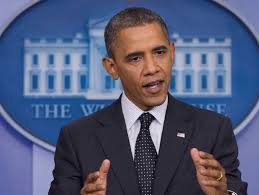So everyone is bashing Obama’s use of red lines on Syria. In Sunday’s New York Times, Daniel Byman took the concept of red lines to task because failure to act on them weakens America’s credibility and reputation:
…when deterrence fails, the United States looks weak and indecisive…. Moreover, not acting after issuing ultimatums harms America’s reputation. As Mr. Rogers and others have argued, inaction makes it more likely that American red lines elsewhere in the region will be questioned, especially in Iran, which is facing pressure on its nuclear weapons program and watching Syria closely.
But here is the question: Does the United States really look weak and indecisive if it fails to follow through on a bluff? The United States uses force at a rate that is several times greater than others – it has already toppled regimes on Iran’s western border and on Iran’s eastern border – and somehow it is the lesson of Syria that is more salient for Iran? More broadly: why should an occasional bluff matter?
Well, actually it doesn’t. Robert Jervis demonstrated four decades ago that signaling is complex business. Jon Mercer’s excellent book on reputation shows that we’ve spent far too much blood and treasure over the folly of preserving our credibility. Daryl Press spent years trying to demonstrate the costs of lost credibility when a state fails to follow through on its threats. His finding? The conventional wisdom on credibility “is wrong.” In his book Calculating Credibility: How Leaders Assess Military Threats, Press writes:
A country’s credibility, at least during crises, is driven not by its past behavior but rather by power and interests. If a country makes threats that it has the power to carry out – and an interst in doing so—those threats will be believed even if the country has bluffed in the past….When assessing credibility during crises, leaders focus on the “here and now,” not on their adversary’s past behavior.
He and Jenny Lind have a nice post on Steve Walt’s blog warning against using the idea that we have to intervene in Syria to defend American credibility in the wake of Obama’s red line. We don’t.
But, this also raises another interesting question. If using red lines (and then not following through) does not really hurt American interests, can they actually help? In other words, maybe issuing a red line threat – even as a bluff — is better than doing nothing.
We have witnessed escalating violence over the past two years in Syria. I think it’s fair to say that from the outset, the Obama administration has had little appetite for a more robust US response – it’s just not clear what could be done. Still, the most pronounced period of escalation in violence is correlated with the three Russian and Chinese vetoes of UNSC resolutions that effectively took international intervention off the table. Amid the escalating violence and little desire by the Obama administration to intervene, what are the feasible and credible US policy options? What could alter the ongoing trend of escalating violence within the constraints that are well known – i.e., short of intervention?
Doing and saying nothing is not likely to alter the trajectory. Arming and training has not been particularly successful — we are providing limited arms and training to the rebels, but as Marc Lynch has repeatedly warned, questions of control over the distribution of these weapons make this a very problematic approach.
In the end, Obama’s use of a red line has been an effort to deter the Syrians from using chemical weapons in the context of a set of broader constraints over what the US can and will do.
If or when it fails, so what? Will being called on the bluff lead to an escalation of violence or make things worse? That presumes that the violence isn’t already escalating for a set of other factors. It’s not clear that others (beyond the neocons) really see it as America looking weak and indecisive. In the end, the use of the red line — even without a plan to follow it up — is a less expensive policy instrument than compellence – which last time I looked in Iraq and Afghanistan hasn’t work so well either. The idea that we should go all in or do nothing has always seemed absurd to me. Make the threat. Sell it and try to dissuade the Syrians from using chemical weapons. If they call our bluff, so be it – at this point it’s really the best in a set of really weak/bad options.
Jon Western has spent the last fifteen years teaching IR in liberal arts colleges at Mount Holyoke College and the Five Colleges in western Massachusetts. He has an eclectic range of intellectual interests but often writes on international security, U.S. foreign policy, military intervention, and human rights. He occasionally shares his thoughts about professional life in liberal arts colleges. In his spare time he coaches middle school soccer, mentors the local high school robotics team, skis, and sails.



I don’t think any rational reader will argue that our credibility is truly on the line in Syria. But as I recall from Press’s book (which I reviewed for the Journal of Military History some years ago) he doesn’t adequately explain how we “calculate credibility” with some of the nut cases we have to deal with these days. It’s a two-way process, & the other side has to clearly recognize what we have the capability to do, if our interests are truly at risk. Saddam, for example, thorougly miscalculated his armed forces’ ability to withstand an American-led attack in 1990 and inflict enough attrition to bring us to the table.
‘Rational Reader,’ ‘Our Credibility’ (Whose?), ‘Nut cases’; please try to be reflexive.
So too did the United States if you look at the pre-war casualty estimates and assessments of Iraqi forces. These were sufficient to spook more than a few congressional members into voting against the authorization to use force. Capability may difficult to assess, but it is still easier and less controversial than intentions—and more stable. Consequently, people fall back on capability as the determining assessment. The next question is at what cost relative to the interests at stake. Press does cover this, but this rapidly moves more into the realm of Alexander George and Yaacov Vertzberger’s work on information in policymaking.
The credibility at stake here is principally normative/ideational; if you want to explain the rise in support for Islamists in Syria, look to the U.S. response to Asad’s actions.